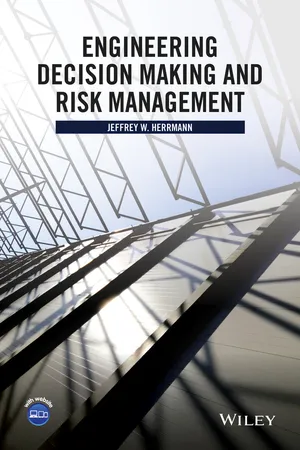
- English
- ePUB (mobile friendly)
- Available on iOS & Android
Engineering Decision Making and Risk Management
About this book
IIE/Joint Publishers Book of the Year Award 2016!
Awarded for 'an outstanding published book that focuses on a facet of industrial engineering, improves education, or furthers the profession'.
Engineering Decision Making and Risk Management emphasizes practical issues and examples of decision making with applications in engineering design and management
Featuring a blend of theoretical and analytical aspects, this book presents multiple perspectives on decision making to better understand and improve risk management processes and decision-making systems.
Engineering Decision Making and Risk Management uniquely presents and discusses three perspectives on decision making: problem solving, the decision-making process, and decision-making systems. The author highlights formal techniques for group decision making and game theory and includes numerical examples to compare and contrast different quantitative techniques. The importance of initially selecting the most appropriate decision-making process is emphasized through practical examples and applications that illustrate a variety of useful processes. Presenting an approach for modeling and improving decision-making systems, Engineering Decision Making and Risk Management also features:
- Theoretically sound and practical tools for decision making under uncertainty, multi-criteria decision making, group decision making, the value of information, and risk management
- Practical examples from both historical and current events that illustrate both good and bad decision making and risk management processes
- End-of-chapter exercises for readers to apply specific learning objectives and practice relevant skills
- A supplementary website with instructional support material, including worked solutions to the exercises, lesson plans, in-class activities, slides, and spreadsheets
An excellent textbook for upper-undergraduate and graduate students, Engineering Decision Making and Risk Management is appropriate for courses on decision analysis, decision making, and risk management within the fields of engineering design, operations research, business and management science, and industrial and systems engineering. The book is also an ideal reference for academics and practitioners in business and management science, operations research, engineering design, systems engineering, applied mathematics, and statistics.
Frequently asked questions
- Essential is ideal for learners and professionals who enjoy exploring a wide range of subjects. Access the Essential Library with 800,000+ trusted titles and best-sellers across business, personal growth, and the humanities. Includes unlimited reading time and Standard Read Aloud voice.
- Complete: Perfect for advanced learners and researchers needing full, unrestricted access. Unlock 1.4M+ books across hundreds of subjects, including academic and specialized titles. The Complete Plan also includes advanced features like Premium Read Aloud and Research Assistant.
Please note we cannot support devices running on iOS 13 and Android 7 or earlier. Learn more about using the app.
Information
Chapter 1
Introduction to Engineering Decision Making
Learning Objectives:
- Identify and describe two types of decisions that engineers make (Section 1.2).
- Classify the decisions that engineers make (Section 1.2).
- Describe how optimization is related to decision making (Section 1.3).
- Describe how problem solving is related to decision making (Section 1.4).
- Explain why decision making is part of risk management (Section 1.5).
- Identify problems that can occur in decision making (Section 1.6).
- Identify the benefits of improving decision making (Section 1.7).
- Describe a decision from three perspectives (Section 1.8).
1.1 Introduction
- What is the value of improving decision making?
- Which alternative is the best one?
- How should our group make a decision?
- How can one compare alternatives in the presence of uncertainty?
- How can we decide when we do not know what the other guy is going to do?
- Which decision-making process is the most appropriate?
- Should we gather more information before deciding?
- How can we reduce risk?
- How do organizations make decisions?
- How can we improve decision making in our organization?
1.2 Decision Making in Engineering Practice
- What should the design be? Design decisions determine the overall structure, shape, size, material, manufacturing process, and components of an object or a system. These generate information about the design itself and the requirements that it must satisfy. Design decisions may involve manufacturing processes and systems. Deciding that gear hobbing will be used to make the bull gear for a re...
Table of contents
- Cover
- Title Page
- Copyright
- Dedication
- Table of Contents
- Preface
- Chapter 1: Introduction to Engineering Decision Making
- Chapter 2: Decision-Making Fundamentals
- Chapter 3: Multicriteria Decision Making
- Chapter 4: Group Decision Making
- Chapter 5: Decision Making Under Uncertainty
- Chapter 6: Game Theory
- Chapter 7: Decision-Making Processes
- Chapter 8: The Value of Information
- Chapter 9: Risk Management
- Chapter 10: Decision-Making Systems
- Chapter 11: Modeling and Improving Decision-Making Systems
- Index
- End User License Agreement